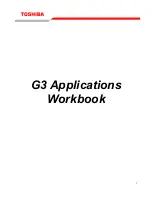
*
For additional assistance, please contact Toshiba Adjustable Speed Drive Marketing Dept. at (800) 872-
2192
6
2
Binary Input
Introduction
Among the many types of speed reference the G3 can accept is a binary coding. The binary code is based
upon the value of the programmed value of the Maximum Output Frequency (MOF) in the UTILITY
PARAMETERS group. A maximum of seven bits is available to code for the desired speed (ten with the option
board). The speed reference is a sum of digits whose value is the MOF divided by a power of two.
The following example allows a frequency setting resolution of 1 Hz when MOF is 64 Hz. Six bits will be
used. The Reset function will not be available in this scenario. F-CC and ST-CC must be hardwired on the
terminal strip to run.
Terminals S1, S2, S3, S4, RES, and R are assigned the functions of binary bits 10 through 5 respectively.
Binary bits 10 through 5 have reference values of MOF/2
1
, MOF/2
2
, MOF/2
3
, MOF/2
4
, MOF/2
5
, and MOF/2
6
respectively. In this example, these values are 32, 16, 8, 4, 2, and 1.
Connections
F CC ST
S1 S2 S3 S4 RES R CC
Example of input combinations and corresponding drive outputs with MOF = 64 Hz
S1-CC (32) S2-CC (16)
S3-CC (8)
S4-CC (4)
RES-CC (2)
R-CC (1)
Frequency Command
closed open open open open open
32
open closed open open closed closed 16+2+1 =
19
closed open open closed open closed 32+16+2 =
50
closed closed closed closed open open 32+16+8+4=
60
open
open
closed
closed
open
open
8+4 =
12
Notes:
Be careful to connect to “R” and not to “RR”.
You may want to set an unused terminal’s function to “42” (binary data write) to store the frequency
command in the drive’s RAM. The drive will keep running at the speed commanded when the binary
data write was given (i.e. the terminal was shorted to CC) even though the contact closures that coded
for the reference may change.This RAM-written reference is lost when the drive is powered down.






































